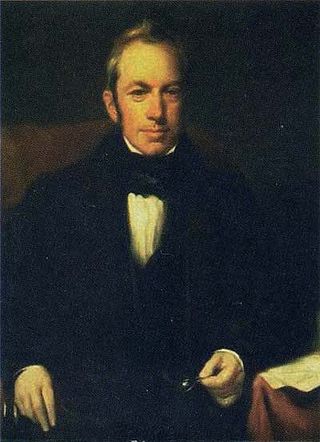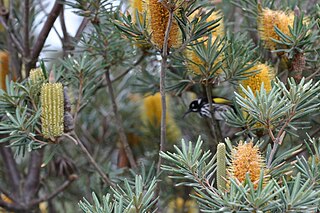Reference section
Notes
- ↑ From the Ends of the Earth, Christian Lamb, Christian Lamb, 2004, ISBN 1-903071-08-9 p 40
- ↑ The Letters of Sir Joseph Banks, Neil Chambers (ed), World Scientific, 2000, ISBN 1-86094-204-0 p 369
- ↑ The Life of Matthew Flinders, Miriam Estensen, Allen & Unwin, 2003, ISBN 1-74114-152-4 p 147
- ↑ Vallance, T.G., Moore, D.T. & Groves, E.W. 2001. Nature's Investigator The Diary of Robert Brown in Australia, 1801-1805, Australian Biological Resources Study, Canberra, (pp.409-410) ISBN 0-642-56817-0
- ↑ The Edinburgh New Philosophical Journal, Robert Jameson, William Jardine and Henry Darwin Rogers, A. and C. Black, 1858 p333
Related Research Articles

George Bass was a British naval surgeon and explorer of Australia.

Robert Brown was a Scottish botanist and paleobotanist who made important contributions to botany largely through his pioneering use of the microscope. His contributions include one of the earliest detailed descriptions of the cell nucleus and cytoplasmic streaming; the observation of Brownian motion; early work on plant pollination and fertilisation, including being the first to recognise the fundamental difference between gymnosperms and angiosperms; and some of the earliest studies in palynology. He also made numerous contributions to plant taxonomy, notably erecting a number of plant families that are still accepted today; and numerous Australian plant genera and species, the fruit of his exploration of that continent with Matthew Flinders.

Jean-Baptiste Louis Claude Théodore Leschenault de La Tour was a French botanist and ornithologist.

Ferdinand Lucas Bauer was an Austrian botanical illustrator who travelled on Matthew Flinders' expedition to Australia.

Banksia coccinea, commonly known as the scarlet banksia, waratah banksia or Albany banksia, is an erect shrub or small tree in the family Proteaceae. Its distribution in the wild is along the south west coast of Western Australia, from Denmark to the Stokes National Park, and north to the Stirling Range, growing on white or grey sand in shrubland, heath or open woodland. Reaching up to 8 m (26 ft) in height, it is a single-stemmed plant that has oblong leaves, which are 3–9 cm (1.2–3.5 in) long and 2–7 cm (0.8–2.8 in) wide. The prominent red and white flower spikes appear mainly in the spring. As they age they develop small follicles that store seeds until opened by fire. Though widely occurring, it is highly sensitive to dieback and large populations of plants have succumbed to the disease.

William Westall was a British landscape artist best known as one of the first artists to work in Australia.
Henry Hacking was an Australian seaman and early explorer in New South Wales. He was responsible for shooting and killing the Aboriginal resistance fighter Pemulwuy in 1802.

Banksia repens, the creeping banksia, is a species of shrub in the plant genus Banksia. It occurs on the south coast of Western Australia from D'Entrecasteaux National Park in the west to Mount Ragged in the east.

Banksia verticillata, commonly known as granite banksia or Albany banksia, is a species of shrub or (rarely) tree of the genus Banksia in the family Proteaceae. It is native to the southwest of Western Australia and can reach up to 3 m (10 ft) in height. It can grow taller to 5 m (16 ft) in sheltered areas, and much smaller in more exposed areas. This species has elliptic green leaves and large, bright golden yellow inflorescences or flower spikes, appearing in summer and autumn. The New Holland honeyeater is the most prominent pollinator, although several other species of honeyeater, as well as bees, visit the flower spikes.

Captain Matthew Flinders was a British navigator and cartographer who led the first inshore circumnavigation of mainland Australia, then called New Holland. He is also credited as being the first person to utilise the name Australia to describe the entirety of that continent including Van Diemen's Land, a title he regarded as being "more agreeable to the ear" than previous names such as Terra Australis.
A Flinders bar is a vertical soft iron bar placed in a tube on the fore side of a compass binnacle. The Flinders bar is used to counteract the vertical magnetism inherent within a ship and is usually calibrated as part of the process known as swinging the compass, where deviations caused by this inherent magnetism are negated by the use of horizontal correctors.

Seal Island in the Great Southern region of Western Australia is approximately 8.5 kilometres (5 mi) south-east of Albany and approximately 3 kilometres (2 mi) offshore from Frenchman Bay in King George Sound. It has a total area of 2.8 hectares. The island is designated as a nature reserve.

The name Australia is derived from the Latin australis, meaning "southern", and specifically from the hypothetical Terra Australis postulated in pre-modern geography. The name was popularised by the explorer Matthew Flinders from 1804, and it has been in official use since 1817, replacing "New Holland," an English translation of the Dutch name, first given by Abel Tasman in 1643 as the name for the continent.

HMS Investigator was the mercantile Fram, launched in 1795, which the Royal Navy purchased in 1798 and renamed HMS Xenophon, and then in 1801 converted to a survey ship under the name HMS Investigator. In 1802, under the command of Matthew Flinders, she was the first ship to circumnavigate Australia. The Navy sold her in 1810 and she returned to mercantile service under the name Xenophon. She was probably broken up c.1872.

A Voyage to Terra Australis: Undertaken for the Purpose of Completing the Discovery of that Vast Country, and Prosecuted in the Years 1801, 1802, and 1803, in His Majesty's Ship the Investigator was a sea voyage journal written by English mariner and explorer Matthew Flinders. It describes his circumnavigation of the Australian continent in the early years of the 19th century, and his imprisonment by the French on the island of Mauritius from 1804–1810.
General remarks, geographical and systematical, on the botany of Terra Australis is an 1814 paper written by Robert Brown on the botany of Australia. It is significant as an early treatment of the biogeography and floristics of the flora of Australia; for its contributions to plant systematics, including the erection of eleven currently accepted families; and for its presentation of a number of important observations on flower morphology.
John Allen was a lead miner, notable as a junior member of the party of naturalists that accompanied the 1801–1803 voyage of HMS Investigator under Matthew Flinders.

Allen Island, also known as Allens Island or Allen's Island, is one of the South Wellesley Islands, in Queensland's Gulf of Carpentaria. It was named by Matthew Flinders after John Allen, a Derbyshire miner who was a member of the party of naturalists that accompanied the 1801–1803 voyage of HMS Investigator under Flinders. Flinders landed a party of botanists on the island on 20 November 1802 to search for plants.

Synaphea spinulosa is a species of small shrub in the flowering plant family Proteaceae. It is endemic to Western Australia. Together with Acacia truncata, it was the first Australian endemic to be scientifically described and named, and the specimen upon which that description is based is the oldest extant specimen of an Australian plant, and very likely among the first Australian plant specimens ever collected.
References
- Estensen, Miriam (2002). The life of Matthew Flinders. Allen & Unwin.